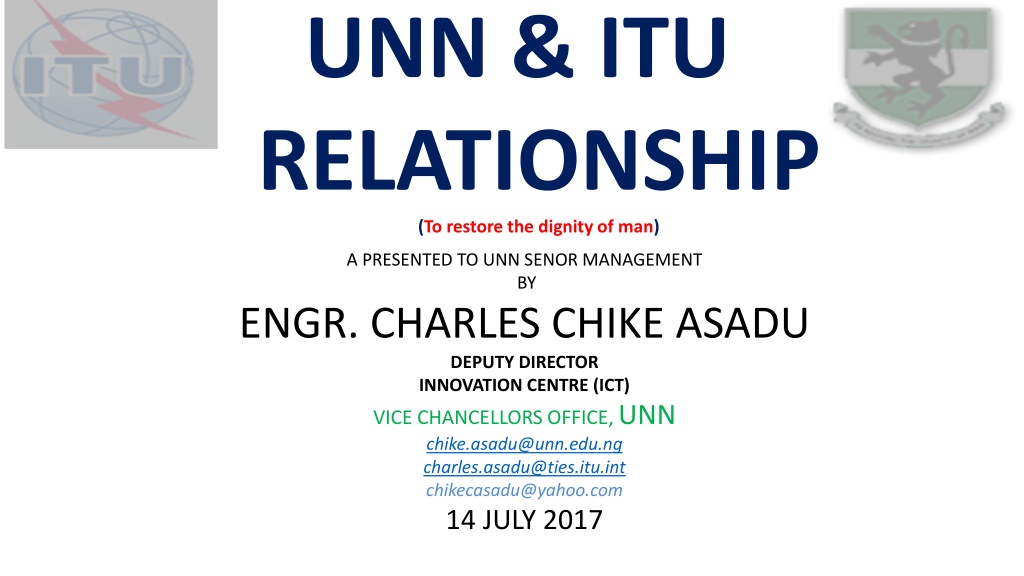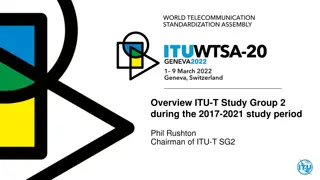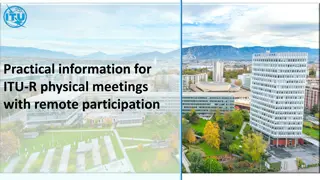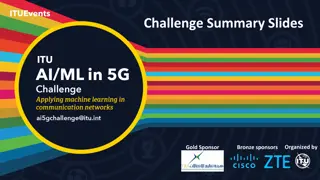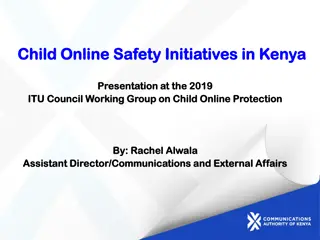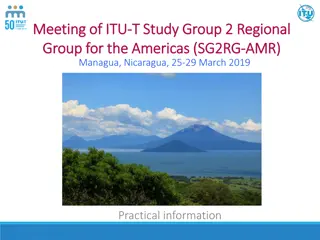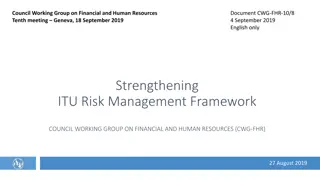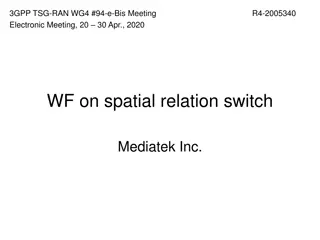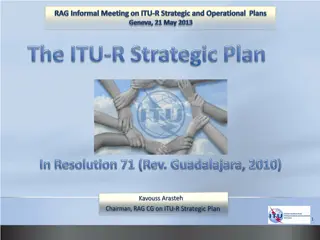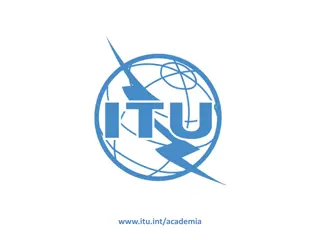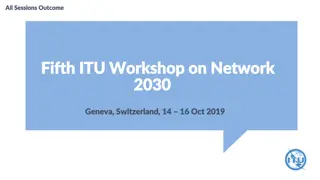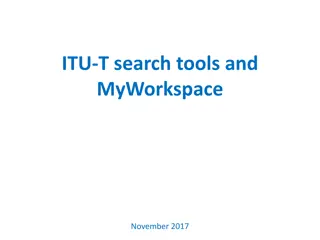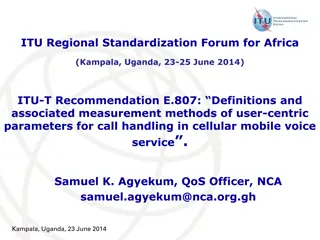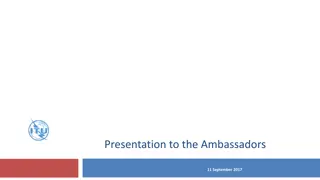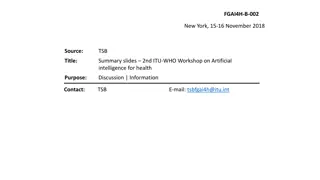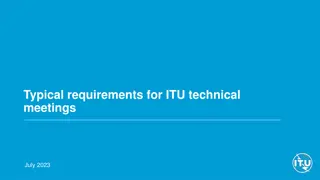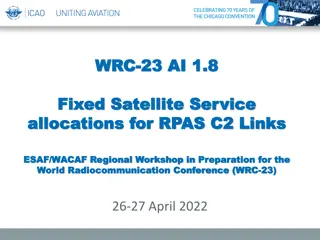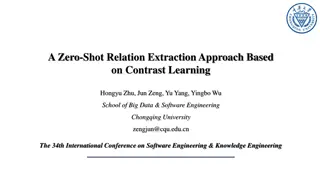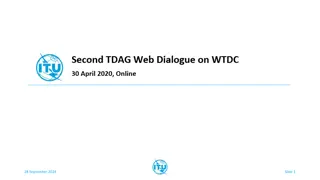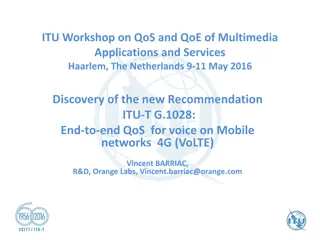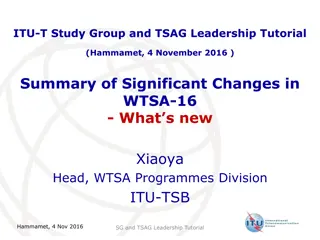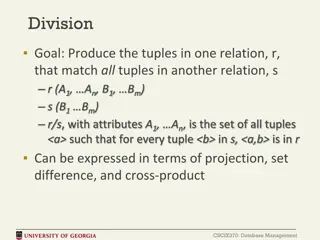UNN & ITU Relationship to Restore the Dignity of Man
The relationship between the University of Nigeria, Nsukka (UNN) and the International Telecommunication Union (ITU) aims to restore the dignity of humanity through education, technological advancement, and global connectivity. UNN's historical perspective, ITU's role in information and communication technologies, and the collaborative efforts to benefit UNN are highlighted in this presentation.
Uploaded on Dec 14, 2024 | 0 Views
Download Presentation

Please find below an Image/Link to download the presentation.
The content on the website is provided AS IS for your information and personal use only. It may not be sold, licensed, or shared on other websites without obtaining consent from the author. Download presentation by click this link. If you encounter any issues during the download, it is possible that the publisher has removed the file from their server.
E N D
Presentation Transcript
UNN & ITU RELATIONSHIP (To restore the dignity of man) A PRESENTED TO UNN SENOR MANAGEMENT BY ENGR. CHARLES CHIKE ASADU DEPUTY DIRECTOR INNOVATION CENTRE (ICT) VICE CHANCELLORS OFFICE, UNN chike.asadu@unn.edu.ng charles.asadu@ties.itu.int chikecasadu@yahoo.com 14 JULY 2017
CONTENT CONTENT 1.UNN IN PERSPECTIVE 2.OVERVIEW OF ITU 3.ITU AND THE ACADEMIA 4.UNN PARTICIPATION IN ITU ACTIVITIES 5.BENEFITS OF ITU TO UNN 6.RECOMMENDATIONS AND CONCLUSION 7.REFERENCE
UNN IN PERSPECTIVE IN THE BEGINNING, ESTABLISHMENT OF UNN AS THE FIRST INDIGINEOUS UNIVERSITY IN NIGERIA WAS INFORMED BY THE NEED TO PRODUCE THE HIGHLY SKILLED MEN AND WOMEN THAT WILL FULFILL THE MANPOWER NEEDS OF THE NEWLY INDEPENDENT NIGERIAN STATE. FORTUNATELY AGAIN, BOTH UNN AND THE INDEPENDENCE OF NIGERIA EMERGED THE SAME YEAR AND MONTH. SINCE INCEPTION, UNN HAS STRIVED TO BE IN THE FOREFRONT OF MANPOWER TRAINING AS WELL AS RESEARCH AND DEVELOPMENT IN THE COUNTRY WITH THE MISSION CHOSEN FOR THE UNIVERSITY BY THE FOUNDING FATHERS AS - TO SEEK TRUTH, TEACH TRUTH AND PRESERVE TRUTH. UNN HAS A TRADITION OF EXCELLENCE FOR WHICH THE INSTITUTION IS KNOWN WITHIN AND OUTSIDE THE COUNTRY, AND UNN REGISTERING WITH ITU AS THE FIST INSTITUTION IN NIGERIA THIS YEAR IS PART OF THE FULFILMENT OF THIS TRADITION
OVERVIEW OF ITU ITU is the United Nations specialized agency for information and communication technologies ICTs. ITU allocate global radio spectrum and satellite orbits, develop the technical standards that ensure networks and technologies seamlessly interconnect, and strive to improve access to ICTs to underserved communities worldwide.
OVERVIEW OF ITU and whatever their means and to protect and support everyone's fundamental right to communicate. As ICTs underpin everything we do today, ITU help to manage and control emergency services, water supplies, power networks and food distribution chains, support health care, education, government services, financial markets, transportation systems and environmental management and allow people to communicate with colleagues, friends and family anytime, and almost anywhere. ITU is committed to connecting the entire world's people wherever they live
OVERVIEW OF ITU ITU was founded in Paris in 1865 as the International Telegraph Union. It took its present name in 1934, and in 1947 became a specialized agency of the United Nations. Although its first area of expertise was the telegraph, the work of ITU now covers the whole ICT sector, from digital broadcasting to the Internet, and from mobile technologies to 3D TV. It is an organization of public-private partnership since its inception. Currently, it has a membership of about 192 countries and some 700 private-sector entities. ITU is headquartered in Geneva, Switzerland, and has twelve regional and area offices around the world. ITU is the oldest UN Agency and celebrated its 150th anniversary in 2015
OVERVIEW OF ITU ROLE OF TIES IN ITU ACTIVITIES: TIES (Telecommunication Information Exchange Service) is a set of networked information resources and services offered by ITU without any charge to ITU Members (Member States, Sector Members, Associates, and Academia) to support their participation in the activities of the Union. TIES accounts are provided, on demand, to staff from ITU Members (Member States, Sector Members, Associates, and Academia). A TIES account provides personalized access (through a username and a password) to a number of services. TIES services are provided to support the participation of Members in the activities of the Union and include email, online collaboration tools, access to ITU meeting documents, automatic email notifications, etc
OVERVIEW OF ITU Some common terms in the operation of ITU: 1. STUDY GROUP: are were Standardization work is carried out in which representatives of the ITU-T membership develop Recommendations (standards) for the various fields of international telecommunications. 2. QUESTION: description of an area of work to be studied, normally leading to the production of one or more new or revised Recommendation 3. WORK ITEM an assigned piece of work which is identifiable with a question and which has specific or general objectives, which will result in a product, usually a Recommendation for publicity by ITU. 4. WORK PROGRAMME: A list of work items that are owned by a study group. 5. RECOMMENDATION: standards defining how telecommunication networks operate and interwork. ITU-T Recs have non-mandatory status until they are adopted in national laws
OVERVIEW OF ITU Contributions to ITU work can be in the form of - Amendments, annex, appendix, clause, corrigendum, implementation guide, supplement, text etc.
OVERVIEW OF ITU Key conferences of ITU are: World Conference on International Telecommunications (WCIT) World Telecommunication Policy Forum (WTPF) World Telecommunication Standardization Assembly (WTSA) World Radiocommunication Conference (WRC) World Telecommunication Development Conference (WTDC) World Summit on the Information Society (WSIS)
OVERVIEW OF ITU 3 SECTORS OF ITU ARE:
OVERVIEW OF ITU The Radocommunication Sector is responsible for: Radio-frequency allocation, satellite orbit management and access technologies, Satellites enable phone calls, television programmes, satellite navigation and online maps. Space services that are vital in monitoring and transmitting changes in such data as ocean temperature, vegetation patterns and greenhouse gases helping to predict famines, the path of a hurricane, or how the global climate is changing. addressing the need for additional radio spectrum allocations and harmonized standards to improve interoperability. coordinating the vast and growing range of radiocommunication services,
OVERVIEW OF ITU ITU-R Study Groups are: Study Gro up 1 (SG 1) - Spectrum management Study Group 3 (SG 3) - Radiowave propagation Study Group 4 (SG 4) - Satellite services Study Group 5 (SG 5) - Terrestrial services Study Group 6 (SG 6) - Broadcasting service Study Group 7 (SG 7) - Science services
OVERVIEW OF ITU ITU-R activities climaxes with World radiocommunication conferences (WRC), which holds every three to four years to review, and, if necessary, revise the Radio Regulations, the international treaty governing the use of the radio-frequency spectrum and the geostationary-satellite and non- geostationary-satellite orbits. Revisions are made on the basis of agenda items (AI) determined by the ITU Council, which takes into account recommendations made by previous world radiocommunication conferences. The general scope of the agenda of world radiocommunication conferences is established four to six years in advance, with the final agenda set by the ITU Council two years before the conference, with the concurrence of a majority of Member States.
OVERVIEW OF ITU Under the terms of the ITU Constitution, a WRC can: revise the Radio Regulations and any associated Frequency assignment and allotment Plans; address any radiocommunication matter of worldwide character; instruct the Radio Regulations Board and the Radiocommunication Bureau, and review their activities; determine Questions for study by the Radiocommunication Assembly and its Study Groups in preparation for future Radiocommunication Conferences.
OVERVIEW OF ITU TYPICALLY, STUDIES FOR EACH AI OF ANY WRC INCLUDE: Background Methods that have been developed to start the study of the AI Summary of technical and operational studies Conducted Analysis of the results of studies Methods to satisfy the agenda item Regulatory and procedural considerations
OVERVIEW OF ITU THE NEXT WRC WILL TAKE PLACE IN 2019 WITH THE AGENDA ITEMS(AI)s LOCATED AT : http://www.itu.int/oth/R1402000001/ ALL INFOMATION CONCERNING THE WRC19 ARE FOUND IN : http://www.itu.int/en/ITU-R/conferences/wrc/2019/Pages/default.aspx
OVERVIEW OF ITU The Standardization Sector is responsible for: ITU standards (called Recommendations) that are fundamental to the operation of today s ICT networks. ITU standards that allow systems to work locally and globally. For instance, the Emmy award-winning standard ITU-T H.264 is now one of the most popular standards for video compression. Product or service that requires international acceptance must be part of the standardization discussions in ITU s Telecommunication Standardization Sector (ITU-T).
OVERVIEW OF ITU The Standardization work Study Groups (SGs) that develop Recommendations (standards) for the various fields of international telecommunicationsare: SG12 - Performance, QoS and QoE SG13 - Future networks (& cloud) SG15 - Transport, Access and Home SG16 - Multimedia SG17 - Security SG20 - IoT, smart cities & communities SG2 - Operational aspects SG3 - Economic and policy issues SG5 - Environment and circular economy SG9 - Broadband cable and TV SG11 - Protocols and test specifications
OVERVIEW OF ITU Typical Questions specific to SG13 for illustration include: Q1/13 - Innovative services scenarios, deployment models and migration issues based on Future Networks Q2/13 - Next-generation network (NGN) evolution with innovative technologies including software-defined networking (SDN) and network function virtualization (NFV) Q5/13 - Applying networks of future and innovation in developing countries Q6/13 - Quality of service (QoS) aspects including IMT-2020 networks Q7/13 - Big data driven networking (bDDN) and Deep packet inspection (DPI) Q16/13 - Knowledge-centric trustworthy networking and services Q17/13 - Requirements, ecosystem, and general capabilities for cloud computing and big data Q18/13 - Functional architecture for cloud computing and big data Q19/13 - End-to-end Cloud computing management and security Q20/13 - IMT-2020: Network requirements and functional architecture Q21/13 - Software-defined networking, network slicing and orchestration Q22/13 - Upcoming network technologies for IMT-2020 and Future Networks Q23/13 - Fixed-Mobile Convergence including IMT-2020
OVERVIEW OF ITU ITU-T Activities climaxes at the World Telecommunication Standardization Assembly (WITSA) WITSA is held every four years and defines the next period of study for ITU-T. WTSA-16 took place in Yasmine Hammamet, Tunisia, from 25 October to 3 November 2016, and was preceded by the Global Standards Symposium on 24 October 2016 Typical fallout of this Assembly include: Resolution 44 that dealt with ways for effective participation of Africans in ITU-T affairs. The development of the requirements and architecture for IMT-2020 UNN has presented papers to these effect to ITU-T Repert of this assembly can be retrieved at: http://www.itu.int/pub/T-RES
OVERVIEW OF ITU The Development Sector is responsible for: programmes to offer investors, manufacturers and marketers presence in emerging markets, demonstrating global ICT leadership, learning how to put good policy into practice, or pursuing mandate for corporate social responsibility. Championing a number of major initiatives which encompass ITU s internationally-accorded mandate to bridge the digital divide , such as its ITU Connect events or Connect a School
OVERVIEW OF ITU The BDT organizes ITU-D institutional conferences (WTDC, RDC) and meetings (RPM, TDAG, Study Groups) as well as thematic, global and regional meetings and events.
OVERVIEW OF ITU World Telecommunication Development Conferences (WTDC) The International Telecommunication Union, through the Telecommunication Development Bureau (BDT), organizes a World Telecommunication Development Conference (WTDC) every four years and a number of Regional Preparatory Meetings (RPMs) within that same period. The Telecommunication Development Conferences serve as forums for free discussion by all concerned with the Development Sector. In addition, they review the numerous programmes and projects of the Sector and BDT. Results are reported and new projects are launched. The World Conferences set the agenda and the guidelines for the following four-year cycle, while the Regional Conferences review "work-in-progress" towards the overall objectives and ensure that goals are met. Each Regional Preparatory Meeting brings together the countries in its region to explore and discuss their needs and the present and future projects of the Sector.
OVERVIEW OF ITU The TDAG meets between the World Telecommunication Development Conferences (WTDC) to advise the Director of the Telecommunication Development Bureau (BDT) on the implementation of the WTDC Action Plan, including issues relating to the budget and the operational plan of the ITU-D. The TDAG is open to representatives of Member States, Sector Members and to chairmen and vice-chairmen of Study Groups. In addition, the Director may invite representatives of bilateral cooperation and development aid agencies, and multilateral development institutions to participate in the meetings.
OVERVIEW OF ITU ITU-D has created two Study Groups . Study Group 1 deals with issues related to the Enabling environment, cybersecurity, ICT applications and Internet-related issues. Study Group 2 deals with issues related to Information and communication Infrastructure and technology development, emergency telecommunications and climate-change adaptation
OVERVIEW OF ITU The forthcoming World Telecommunication Development Conference (WTDC-17) will be convened in Buenos Aires, Argentina, from 9 to 20 October 2017 following the kind invitation of the Government of Argentina and the approval by the Council with the concurrence of a majority of the Member States of ITU. It was preceded by six regional preparatory meetings, two in the last quarter of 2016 and four in the first quarter of 2017, starting in the Commonwealth of Independent States (CIS), then Africa, Arab States, Americas, Asia-Pacific, and Europe. World telecommunication development conferences (WTDCs) are convened in the period between two Plenipotentiary Conferences to consider topics, projects and programmes relevant to telecommunication development. WTDCs set the strategies and objectives for the development of telecommunication/ICT, providing future direction and guidance to the ITU Telecommunication Development Sector (ITU-D)
OVERVIEW OF ITU The theme of WTDC-17 is "ICT for Sustainable Development Goals" - ICT SDGs. The draft agenda of WTDC-17, as approved by the ITU Council with the concurrence of a majority of the Member States. Expected outcomes of WTDC-17 include: a Declaration reinforcing the political Support for the mission and strategic objectives of ITU-D; an ITU-D Contribution to the ITU Strategic Plan for 2020-2023; and an ITU-D Action Plan comprising regional initiatives, new and revised resolutions and recommendations to support the fulfilment of the Sector s objectives, and new and revised Questions to be studied by ITU-D study groups
OVERVIEW OF ITU Highlights of Draft agenda of WTDC-17: I. Report on the implementation of the Dubai Action Plan 2.Sharing success stories and lessons learned from implementing the Dubai Action Plan 3.Report of the Telecommunication Development Advisory Group 4. Report of Study Groups 5. Report on the implementation of outcomes of other ITU Conferences, Assemblies and meetings related to ITU-D work: a.Plenipotentiary Conference (PP-14) b. Radiocommunication Assembly (RA-15)/World Radiocommunication Conference (WRC-15) c.World Telecommunication Standardization Assembly (WTSA-16) 6.ITU-D contribution to World Summit on the Information Society Action Lines
OVERVIEW OF ITU Highlights of Draft agenda of WTDC-17 cont. II. ICT policies and strategies for achieving Sustainable Development Goals - Ministerial and Industry leaders roundtables III.ITU-D work plan for 2018-2021 1. Outcomes of Regional Preparatory Meetings for WTDC-17 2. ITU-D contribution to the ITU Strategic Plan for 2020-2023 3. ITU-D Action Plan for 2018-2021 4. WTDC-17 Declaration 5. Telecommunication Development Advisory Group a. Authorization for the Telecommunication Development Advisory Group to act between world telecommunication development conferences (Resolution 24, Rev. Dubai, 2014) b. Structure and working methods
OVERVIEW OF ITU Highlights of Draft agenda of WTDC-17 Cont. 6. Study Groups : ie, a. Study Questions b. Structure and working methods 7. Resolutions and recommendations 8. Financing mechanisms for ICT development a. Partnerships b. Role of the private sector
OVERVIEW OF ITU Draft ITU-D contribution to the ITU Strategic Plan for 2020-2023: objectives. D.1 Coordination: Foster international cooperation and agreement on telecommunication/ICT development issues Outcomes: D.1-1: Enhanced review and increased level of agreement on the draft ITU-D contribution to the draft ITU strategic plan, the World Telecommunication Development Conference (WTDC) Declaration, and the WTDC Action Plan. D.1-2: Assessment of the implementation of the Action Plan and of the WSIS Plan of Action. D.1-3: Enhanced knowledge-sharing, dialogue and partnership among Member States, Sector Members, Associates, Academia and other stakeholders on telecommunication/ICT issues. outputs D.1-1 World Telecommunication Development Conference (WTDC) and WTDC Final Report D.1-2 Regional Preparatory Meetings (RPMs) and Final Reports of the RPMs D.1-3 Telecommunication Development Advisory Group (TDAG) and reports of the TDAG for the BDT Director and for WTDC D.1-4 Study Groups and guidelines, recommendations and reports of Study Groups D.1-5 Platforms for regional coordination, including Regional Development Forums (RDFs) [New] D.1-6: Partnership platforms, products and services
OVERVIEW OF ITU Draft ITU-D contribution to the ITU Strategic Plan for 2020-2023: objectives D.2 Modern and secure telecommunication/ICT Infrastructure: Foster the development of infrastructure and services, including building confidence and security in the use of telecommunications/ICTs Outcomes D.2-1: Enhanced capacity of ITU Membership to make available resilient telecommunication/ICT infrastructure and services, including broadband and broadcasting, bridging the digital standardization gap, conformance and interoperability and spectrum management. D.2-2: Enhanced capacity of ITU Membership to effectively respond to cyber threats and develop national cybersecurity strategies and capabilities, including capacity building. D.2-3: Strengthened capacity of Member States to use telecommunication/ICT for disaster risk reduction and emergency telecommunications. outputs D.2-1 Products and services on telecommunication/ICT infrastructure and services, including broadband and broadcasting, bridging the digital standardization gap, conformance and interoperability and spectrum management D.2-2 Products and services on building confidence and security in the use of telecommunications/ICTs D.2-3 Products and services on disaster risk reduction and emergency telecommunications
OVERVIEW OF ITU Draft ITU-D contribution to the ITU Strategic Plan for 2020-2023: objectives D.3 Enabling Environment: Foster an enabling policy and regulatory environment conducive to sustainable telecommunication/ICT development outcomes D.3-1: Strengthened capacity of Member States to develop enabling policy, legal and regulatory frameworks conducive to development of telecommunications/ICTs. D.3-2: Strengthened capacity of Member States to produce high-quality, internationally comparable ICT statistics based on agreed standards and methodologies. D.3-3: Improved human and institutional capacity of ITU Membership to tap into the full potential of telecommunications/ICTs. D.3-4: Strengthened capacity of ITU Membership to integrate telecommunication/ICT innovation in national development agendas. outputs D.3-1 Products and services on telecommunication/ICT policy and regulation D.3-2 Products and services on telecommunication/ICT statistics D.3-3 Products and services on human and institutional capacity building D.3-4 Products and services on telecommunication/ICT innovation
OVERVIEW OF ITU Draft ITU-D contribution to the ITU Strategic Plan for 2020-2023: Objectives D.4 Inclusive Digital Society: Foster the development and use of telecommunications/ICTs and applications to empower people and societies for socio-economic development and environmental protection Outcomes D-4-1: Improved access to and use of telecommunication/ICT in Least Developed Countries (LDCs), small island developing states (SIDS) and landlocked developing countries (LLDCs) and countries with economies in transition. D.4-2: Improved capacity of ITU Membership to leverage ICT applications, including mobile, in high-priority areas (e.g. health, agriculture, commerce, governance, education, finance). D.4-3: Strengthened capacity of ITU Membership to develop strategies, policies and practices for digital inclusion, especiallypeople with specific needs. D.4-4: Enhanced capacity of ITU Membership to develop ICT strategies and solutions on climate-change adaptation and mitigation. Outputs D.4-1 Products and services on concentrated assistance to LDCs, SIDS and LLDCs and countries with economies in transition D.4-2 Products and services on ICT applications D.4-3 Products and services on digital inclusion of people with specific needs D.4-4 Products and services on ICT climate-change adaptation and mitigation
ITU AND THE ACADEMIA In October 2010, ITU officially opened its work to academia - universities and their associated research establishments for a trial period of four years. COST OF MEMBERSHIP: Member States and Sector Members pay in contributory units and, above a minimum amount, may freely choose their annual contribution. Academia, universities and their associated research establishments benefit from preferential rates, as do Sector Members from some developing countries. ITU Academia can participate in the work of all three sectors (ITU-R, ITU-T and ITU-D) at the following cost: 3,975 CHF a year (Developed Countries) 1,987 CHF a year (Developing Countries) One CHF = one Dollar
ITU AND THE ACADEMIA Each Sector of ITU has a number of Study Groups related to the sectors specific field. Academia has the opportunity to contribute their ideas and expertise on important topics through various Study Groups. Study Group themes include: Policy and Regulatory Reform Next generation network Big Data Smart/Sustainable Cities Cybersecurity E-waste Connected car IoT Cloud Computing Spectrum Management Rural Connectivity Climate Change Economics of Roaming Disaster Relief Digital Financial Inclusion and more
ITU AND THE ACADEMIA registered members of the ITU Academia with 24 registered institutions. - https://www.itu.int/online/mm/scripts/gensel11?_memb=U It has to be noted that Argentina has the highest number on the list of Conference (WTDC-17) will be convened in Buenos Aires, Argentina? Should that be why the forthcoming World Telecommunication Development
ITU AND THE ACADEMIA UNN formally registered with ITU early this year. Prior to its registration with ITU, UNN made several visits to Abuja to: distribute letter of expression to register with ITU to many organizations'. the First VC visit to MOC, where the VC interacted with the HMC, resulting in the VC nomination to be part of the Minister s team for ITU Conference to BANKOK 14 17 November 2016 The Second VC visit to HMC: where the VC explicitly expressed the intention of UNN to register with ITU under the Academia
ITU AND THE ACADEMIA UNN has severally participated in ITU activities: Participation in ATU WTDC preparatory meeting in Rwanda, NOVEMBER 2016 ITU-D e-meeting January 2017 ITU-T SG13 February 2017 ITU-T REGPREP4AFR in Egypt April 2017 ITU-T SG13 RAPPORTUER MEETING July 2017
UNN PARTICIPATION IN ITU ACTIVITIES Generally, Participation in ITU activities will be in the following: Study Groups ITU Academy & Centres of Excellence ITU Kaleidoscope Events Contribution to the ITU research projects Contribution to the technical & policy regulatory papers ICT Challenges International Academia Online Network Ad-hoc Group on Education about Standardization Internships for students
UNN PARTICIPATION IN ITU ACTIVITIES UNN commenced registration with ITU with the desire to making overtures with: Ministry of Communications (MOC), Nigerian Communication commission(NCC), Nigeria Aerospace Research Space Development Agency (NARSDA), National Information Technology Development Agency ( NITDA), Nigeria Communication Satellite (NIGCOMSAT), Telecom operators like MTN, ETEL, GLO, ETISALATE, NUC, TEDFUND etc. Today, UNN is a registered member with ITU under the Academia
UNN PARTICIPATION IN ITU ACTIVITIES Implications of UNN registering with ITU include: Need to review of curriculum relating to the Focus Departments to drive UNN ITU relation Need for the establishment of Department of Computer/Robotics Engineering Need to identify Focus Departments, eg: computer/robotics, electronic, materials engineering; computer science, physics, math's, statistics departments; computer education, educational technology, mass communication, arts and music departments; library and library studies department; etc APPRAISAL OF FACILITIES/EQUIPMENT IN FOCUS DEPARTMENTS Staff needs NEED FOR A COORDINATED ACTIVITIES OF THE UNITED NATIONS INTERVATION PROGRAMMES AT UNN AT THE 0FFICE OF VC.
UNN PARTICIPATION IN ITU ACTIVITIES UNN has participated in the following ITU meetings: 1. ITU-D African preparatory meeting in Kigali November 2016 2. ITU-T SG 13 MEETING IN Geneva February 2017 3. Fifth SG13 Regional Workshop for Africa on ITU-T Standardization Work on Future Networks: Towards a Better Future for Africa (Cairo, Egypt, 03-04 April 2017) where the following papers where presented: T17-SG13RG.AFR-C-0003!!MSW-E.docx IMT-2020 Requirement for Africa T17-SG13RG.AFR-C-0004!!MSW-E.docx implementation of Res 44 Proposed work on gap analysis on IMT-2020 (non radio) in developing countries to Q5/13, ITU-T Nigeria designated to head IMT-2020 issues, and co-coordinator for SDN and Cyber security for Africa 4. ITU-T SG 13 Rapporteur meeting 3-14 July 2017 where the papers presented in Egypt will be followed up.
UNN PARTICIPATION IN ITU ACTIVITIES A TYPICAL PULICATION NOTICE AND PREVAILING REQUEST FOR PAPER PRESENTATION IS AS BELOW: Kaleidoscope 2017: The deadline to submit a paper to Kaleidoscope 2017: Challenges for a data-driven society has been extended to 10 July 2017. Kaleidoscope 2017 will explore innovative approaches to data management and analysis, encouraging the development of data-driven applications and services of benefit to society. The conference will be held in Nanjing, China, 27-29 November 2017, hosted by the Nanjing University of Posts and Telecommunications. A call for original academic papers invites submissions investigating the technical, business and policy challenges underlying effective data management and analysis.
UNN PARTICIPATION IN ITU ACTIVITIES ITU Kaleidoscope Eventos is an Annual academic conference to facilitate networking and provide a platform for dialogue between experts and academia on the standardization of ICTs Total prize of USD 10,000 for top 3 papers Best papers published in IEEE Communications Magazine Global recognition for your research and your top students Kaleidoscope 2015 - Trust in the Information Society Barcelona (Spain), 9-11 December 2015
